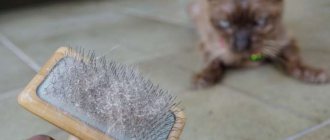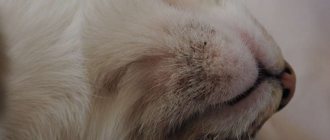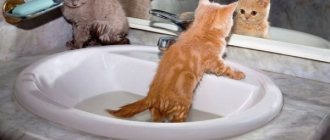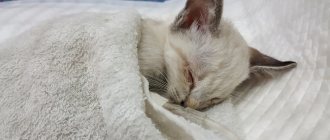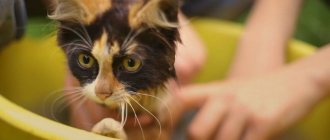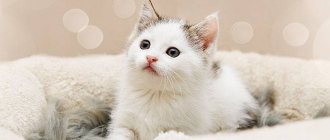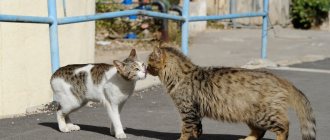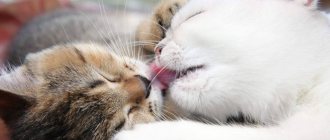Cats are one of the most popular pets today. These proud, independent animals attract with their tenderness towards their owners and genuine love, which cannot be earned, because if a cat loves, it is definitely not for something, but in spite of everything. Therefore, many owners study with interest the appearance and behavior of their charges. Some particularly attentive cat lovers are interested in where a cat’s belly button is. Think about it, has the same question ever crossed your mind? Do cats actually have a belly button? Today we’ll talk about this.
Physiological significance
It is reasonable to assume that all animals that are carried by a mother inside her body have a navel. After all, it is through the umbilical cord that the developing fetus receives through the placenta from the mother’s body all the necessary nutrients that are needed to support nascent life, build a new organism, its successful formation and development, and saturate the cells of the small lump with oxygen. This, accordingly, applies to cats.
A cat carries her kittens for about two months (sixty-five days to be exact). All this time, through the umbilical cord, the fetus receives everything it needs from the mother. During the birth process, after the birth of each kitten, their mother releases an afterbirth (this is the placenta). The cat independently bites the umbilical cord of all newborns. It is obvious that the umbilical cord, on the one hand attached to the placenta, on the other hand is attached directly to the kitten. This means that just like humans, cats have a navel, regardless of their breed.
Therefore, we can safely give a positive answer to the question of whether cats have a navel. How can you detect it in your cat?
Treatment and diagnosis
On the cat owners forum you can find many stories about umbilical hernia in pets. Veterinarians and experienced felinologists strongly recommend consulting with a surgeon and not self-medicating.
The doctor makes an individual decision for each specific case:
- Prescribes, if necessary, examination of the convexity: x-ray or ultrasound;
- Applies conservative treatment: sets prolapsed organs and fixes the navel area with a bandage. Within one to two months, the purr will need a consultation and examination by a veterinarian.
Performs an operation: removes the hernial sac and stitches the umbilical opening. The animal is put on a blanket or a protective collar for two weeks so that the baby does not lick or break the postoperative suture.
You should know:
Surgical intervention is performed on a teenage kitten only when it is already possible to select the minimum dose of anesthesia.
Where to look for a cat's belly button?
It’s not enough to theoretically consider the question of whether cats have a navel; you should certainly make sure in practice that your pet has one. It is important to remember that a cat's belly button is different from a human's. And this is logical, because we belong to different species, therefore, most of the signs in humans and cats are strikingly different. That is why you should not try to find a depression on your cat’s body that is identical to a human one. No, you need to find out where a cat’s belly button is in a completely different way.
The navel is located on a cat's stomach, similar to the location of a human. No hair grows where a cat's belly button should be. But finding what you are looking for the first time can still be problematic, because it can be covered with the fur that surrounds it. Although the appearance of the navel may vary between cats, depending on their size, breed and age, the navel is predominantly a small round or oval area of belly skin, not covered with hair, which is located between the animal's two lower nipples.
Depending on the cat's breed and the quality of its fur, detecting the belly button may be easier or more difficult. The longer a cat's fur, the more difficult it is to detect. Conversely, it is very easy to find the navel in short-haired or even completely hairless cats. If you look carefully, the navel cannot be confused with a nipple or with any other neoplasms.
Causes of umbilical hernia
In its structure, the pathology is a small opening (canal, gate), the part of the abdominal wall emerging from it forms a hernial sac. The movement of nearby organs occurs into it: the uterus or its parts, the bladder, the peritoneal omentum, and intestinal loops. Organs displaced from their anatomical places form hernial contents.
The umbilical type of the disease is most often observed in small kittens due to abnormalities in intrauterine development. In adult animals, hernias are acquired.
Veterinary experts believe that the following factors lead to the appearance of pathology in pets:
- Genetic predisposition is one of the main reasons for the formation of an umbilical hernia. The genes are responsible for the formation of the umbilical ring during fetal development. Malfunctions in the gene apparatus lead to an abnormal structure of the ligamentous apparatus and the umbilical vein, which provokes the formation of the umbilical opening.
- Some breeders believe that the cause of the pathology is the owner’s incorrect actions when the umbilical cord breaks, which leads to the expansion of the umbilical ring. The inexperience of a young mother cat that incorrectly gnaws the umbilical cord of newborns can also lead to trouble.
- Increased intra-abdominal pressure is a common cause of development. In both small kittens and adult animals, blood pressure increases with severe constipation, vomiting, and excessive physical activity.
- Various injuries and mechanical damage are the cause of acquired pathology. Falls from heights, blows, and bruises lead to stretching of the abdominal muscles and displacement of internal organs.
We recommend reading about what to do if your cat develops a tumor. You will learn about the reasons for opening a tumor, the rules for treating a wound, and treating a tumor. And here is more about the reasons why a cat doesn’t eat.
Why do misunderstandings arise?
Often caring, but overly emotional cat owners mistake the cat's navel for symptoms of some disease, for example, lichen or scabies. Unnecessary visits to the veterinarian become a serious stress for both the animal and its owner. Therefore, it is important to know whether cats have a belly button, to be able to find it on your pet’s body, and not to confuse it with really serious manifestations.
Be attentive to your pets, take care of them properly, and then their sincere, selfless gratitude will not take long to arrive. The more attention given to pets, the happier they become and the more joy they bring to their owners. Don't be afraid to be curious and learn more about your pets!
Signs for urgent medical attention
A cat has a wet nose: why is it cold and what does it mean?
Possible umbilical complications occur especially often in newborn pets. Contacting a veterinarian is necessary when a depressed general condition is observed. The newborn may refuse to eat, and an increase in temperature may also be observed.
The infected navel is red and swollen. This place can become a point of entry for infection. The navel becomes inflamed when the mother chews the stump too short. The disease can also occur if the mother has dental disease.
Veterinary products
An infected belly button often begins to fester. The umbilical stump is closely connected to the kitten's internal organs. For example, infection poses a real threat to the liver.
Important! Septicemia develops if left untreated and leads to the death of the individual.
To prevent the death of valuable breeds, breeders treat the navel of a newborn with iodine. If necessary, treatment with disinfectants must be repeated.
If local treatment does not improve the condition, general treatment is used. For example, a doctor may prescribe antibacterial drugs that are administered intravenously or intramuscularly. Sometimes stimulant therapy is used. Modern veterinarians successfully use new homeopathic remedies.
Important! Veterinarians consider umbilical diseases to be infectious. Even at the first signs, the disease can be transmitted to all kittens born.
It is usually not necessary to see a doctor too urgently due to the discovery of a navel. Any movement from a familiar environment is stressful for the animal. Care and attention are important for a pet, in this case he will respond with sincere gratitude. The owner's curiosity will help prevent the development of a serious illness. After all, the health of a pet is a truly important aspect for everyone’s well-being.
About regional development
“The desire of the region’s leadership to make it successful must and will be supported. For successful development, it is necessary to reduce the burden of debt obligations. This issue needs to be carefully considered."
“I propose to restructure the budget loans that were provided to the regions last year to implement measures to combat the epidemic. These loans mature in two months, on July 1. I propose to extend them until 2029.”
“We will provide a fundamentally new development tool - infrastructure budget loans at a rate of no more than 3% per annum and a repayment period of 15 years. By the end of 2023, we plan to allocate such infrastructure loans in the amount of at least 500 billion rubles.”
“We need to speed up the construction of the Moscow-Kazan highway and, moreover, extend it to Yekaterinburg. Complete this project in three years.”
saving
Russian President Vladimir Putin during his annual address to the Federal Assembly
Photo: IZVESTIA/Kristina Kormilitsyna
How to recognize the symptoms?
A deviation from the norm that the pet owner should pay attention to is the prolonged healing of the navel after birth. Every person who has a cat should know what such a deviation looks like in order to take the pet to the veterinary clinic in time
An umbilical hernia in a newborn kitten can go undetected for a long time, causing treatment to be delayed. Owners should be alarmed if their pet’s umbilical cord has not fallen off 14 days after birth, as this may be the first symptom of the progression of the pathology. In a kitten, an umbilical hernia is accompanied by a lump in the abdominal area, which may not cause pain. As the hernial protrusion increases, pain syndrome subsequently appears. Additional symptoms are observed only if other internal organs are pinched. With an umbilical hernia, the following clinical picture in a kitten is likely:
Every person who has a cat should know what such a deviation looks like in order to take the pet to the veterinary clinic in time. An umbilical hernia in a newborn kitten can go undetected for a long time, causing treatment to be delayed. Owners should be alarmed if their pet’s umbilical cord has not fallen off 14 days after birth, as this may be the first symptom of the progression of the pathology. In a kitten, an umbilical hernia is accompanied by a lump in the abdominal area, which may not cause pain. As the hernial protrusion increases, pain syndrome subsequently appears. Additional symptoms are observed only if other internal organs are pinched. With an umbilical hernia, the following clinical picture in a kitten is likely:
- gagging;
- the wound in the navel area bleeds and does not heal well;
- loss of appetite;
- increased body temperature;
- digestive problems;
- broken stool;
- death of tissue around the navel.

